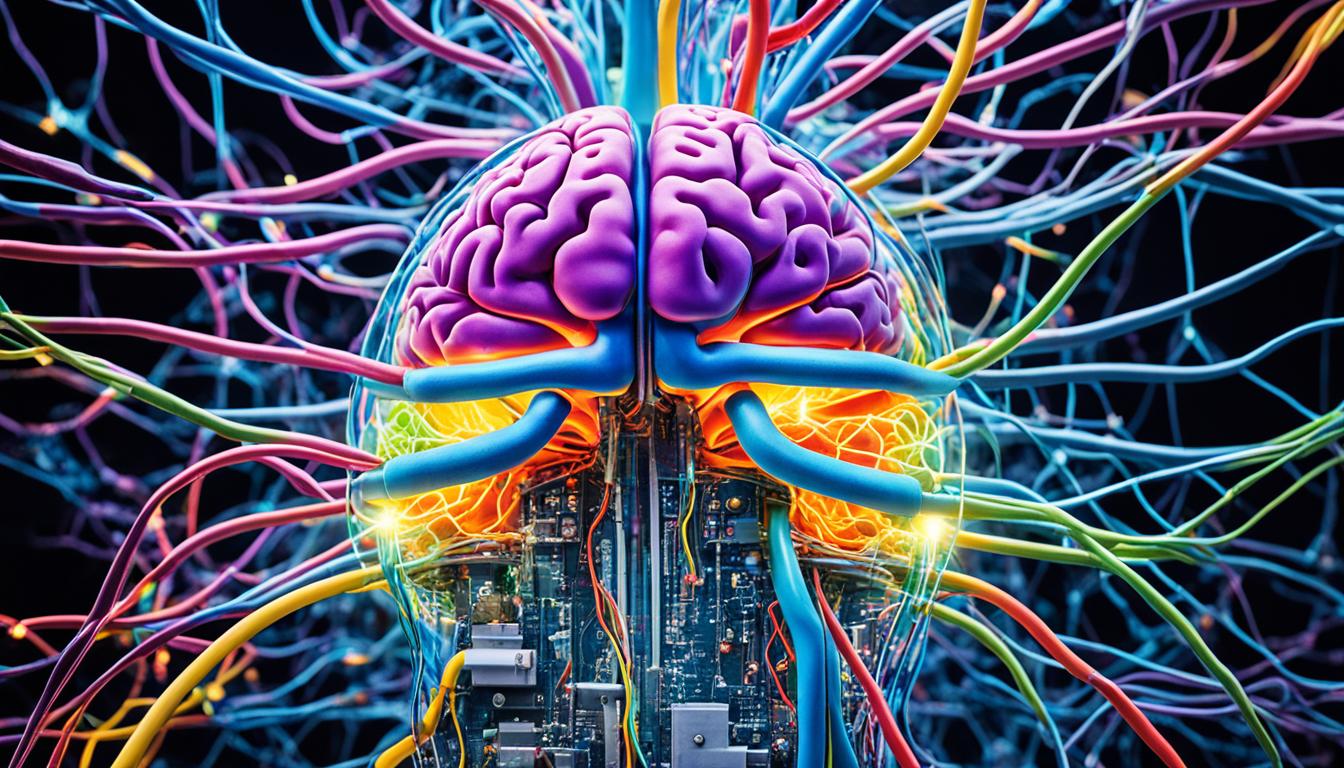Did you know that the human brain consists of a staggering network of billions of neurons? These intricate neural connections allow for the complex processing of information and the generation of thoughts, memories, and actions. But how does neuron activation play a role in unlocking the brain’s potential and enabling cognitive function?
In this article, we will explore the fascinating world of neuron activation and how it influences our brain’s capabilities. From understanding the misconception surrounding the “using more of the brain” equals intelligence myth to delving into the complex neural networks and emergent phenomena, we will unveil the secrets of cognitive processes and their connection to neuron activation. Additionally, we will examine the interplay between artificial intelligence and neuron activation, shedding light on the similarities and differences between biological and technical concepts of neuron function.
Join us on this journey as we uncover the mysteries behind neuron activation and its profound implications for unlocking brain potential and advancing cognitive function.
Key Takeaways:
- Neuron activation is crucial in unlocking the brain’s potential and enabling cognitive function.
- The misconception that using more of the brain equates to intelligence is debunked.
- The brain’s complex neural networks and non-linear functioning contribute to creativity.
- Smartness is determined by the acquisition of relevant skills and knowledge.
- Neuron activation plays a fundamental role in cognitive processes and information processing.
The Misconception of “Using More Brain” Equals Intelligence
Many people hold the mistaken belief that using a greater percentage of their brain leads to increased intelligence. However, this is a misconception that can be debunked by understanding the effects of a seizure on mental capability.
Seizure Example and Reduced Mental Capability
During a seizure, there is a high level of brain activation. However, this excessive activation does not result in heightened intelligence. On the contrary, it leads to a reduced mental capability, with individuals unable to perform even basic tasks like talking or walking. This example clearly demonstrates that brain activation alone is not a measure of intelligence.
Non-Linear Functioning and Creativity of the Brain
The functioning of the brain is far more complex and non-linear than the simple notion of using more brain equating to higher intelligence. Unlike computers, which operate in a linear and deterministic manner, the brain’s neural network functions in a non-linear and asynchronous fashion. This non-linear processing allows the brain to recognize patterns, generate new ideas, and think outside the box. It is this non-linear functioning that facilitates creativity and innovative thinking.
Understanding Smartness: Learning Relevant Skills
Smartness is not solely determined by the level of brain activation but rather by the acquisition and application of relevant skills and knowledge. The brain is constantly learning and adapting to new information, regardless of the specific task or field. To enhance smartness, individuals should focus on developing and mastering skills that are valuable in their chosen field or area of interest. In this way, they can harness their brain potential and cognitive abilities effectively.
Neuron Activation: The Bedrock of Cognitive Processes
Neuron activation serves as the foundation for various cognitive processes in the brain. The brain consists of complex networks of neurons working together to process and transmit information, leading to emergent phenomena such as thoughts, memories, and decision-making.
This intricate interplay of neurons and their activation holds the key to understanding the mysteries of cognitive processes. By deciphering the complexities of neural networks and their activation, we can gain deeper insights into the functioning of the brain and its potential capabilities.
Complex Neuronal Networks and Emergent Phenomena
The brain’s neural networks consist of numerous interconnected neurons, forming complex pathways that facilitate information processing. When these neurons are activated, they generate emergent phenomena, allowing the brain to perform tasks and exhibit cognitive functions.
This emergent behavior arises from the collective activity of neurons, creating a system that is greater than the sum of its parts. These phenomena include the generation of thoughts, the formation of memories, and the ability to make decisions based on available information.
Understanding how these complex neural networks give rise to emergent phenomena is an ongoing pursuit in neuroscience. Researchers seek to unravel the mechanics behind these phenomena, shedding light on the remarkable capabilities of the human brain.
Roles of Excitatory and Inhibitory Signals
Neuron activation involves the interplay between excitatory and inhibitory signals, which play essential roles in regulating neural communication and information processing.
Excitatory signals stimulate the firing of neurons, triggering neural activity and facilitating the transmission of information. These signals allow neurons to communicate and form connections, enabling the brain to process and interpret incoming stimuli.
In contrast, inhibitory signals dampen or prevent neural activity, providing a mechanism to regulate and balance the brain’s overall function. The delicate balance between excitation and inhibition is crucial for maintaining proper brain function, preventing overactivity, and ensuring the efficiency of cognitive processes.
Disruptions in the balance of excitatory and inhibitory signals can result in neurological disorders and cognitive impairments. Understanding the intricacies of these signals and their impact on neuronal activation is essential for advancing our knowledge of brain function and its potential applications.
In Summary
Neuron activation serves as the bedrock of cognitive processes in the brain, enabling emergent phenomena and facilitating complex neural networks. The interplay between excitatory and inhibitory signals regulates neural communication and information processing, ensuring the brain’s efficient and balanced function. Gaining a deeper understanding of neuron activation and its role in cognitive processes brings us closer to unlocking the potential of the brain and developing advanced applications in fields such as neuroscience and artificial intelligence.
Artificial Intelligence and Neuron Activation
The field of artificial intelligence (AI) is closely intertwined with the concept of neuron activation, which plays a fundamental role in machine learning. To fully grasp this connection, it is essential to understand the distinctions between the biological and technical concepts of neuron function.
Biological vs. Technical Concepts of Neuron Function
In the human brain, cognition is underpinned by the activity of biological neurons. These neurons form intricate networks that facilitate information processing and cognitive functions. On the other hand, technical concepts in AI aim to replicate and harness the power of neuron activation to enable machine learning. By comprehending both the biological and technical aspects of neuron function, researchers can develop AI algorithms that closely mimic the cognitive processes of the human brain.
Non-Linear Learning in Machine Learning
In machine learning, neural networks employ the pivotal concept of neuron activation for pattern recognition, prediction, and complex task execution. Unlike traditional linear learning, non-linear learning through neuron activation allows neural networks to process and analyze vast amounts of data, enabling them to adapt and learn from new information. This non-linearity is essential for capturing and modeling complex relationships and patterns within the data. The role of neuron activation in machine learning is instrumental in enhancing AI systems, providing them with the capacity to perform intricate cognitive tasks.
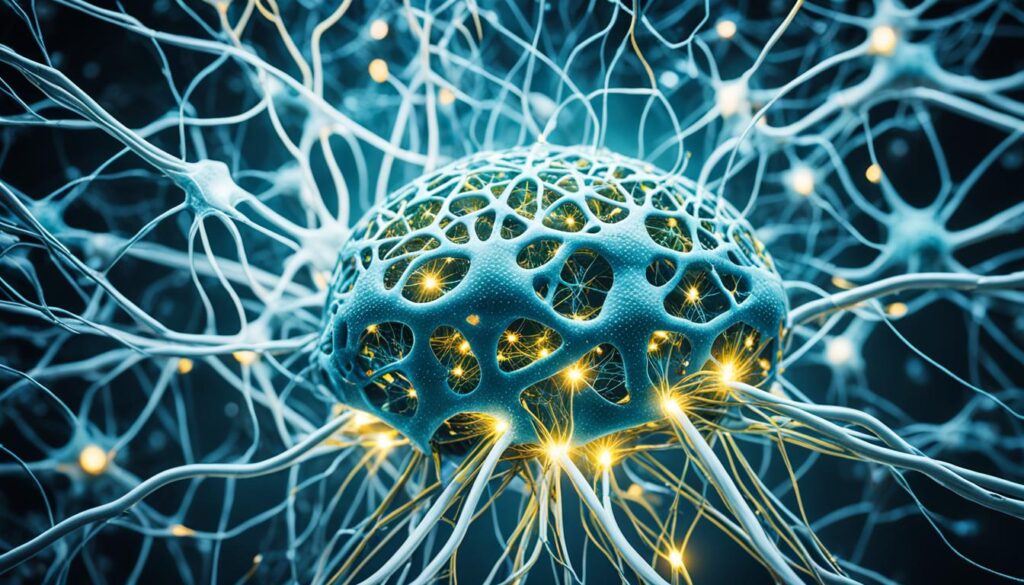
| Artificial Intelligence | Neuron Activation | Machine Learning |
|---|---|---|
| Replicates neuron activation | The foundation for cognition in the human brain | Non-linear learning through activation in neural networks |
| Mimics human cognitive processes | Biological basis for information processing | Recognizes patterns, predictions, and complex tasks |
| Develops AI algorithms | Understands both biological and technical concepts | Processes and analyzes vast amounts of data |
Understanding how artificial intelligence and neuron activation intersect opens up new possibilities for developing advanced AI systems that closely resemble the cognitive capabilities of the human brain.
The Activation-Synthesis Theory in Neuroscience and AI
The activation-synthesis theory, originating in neuroscience, suggests that the random neural activations during REM sleep are synthesized by the brain into dream content. This theory provides a framework for understanding the generation of dreams and the connection between neural activations and dream experiences.
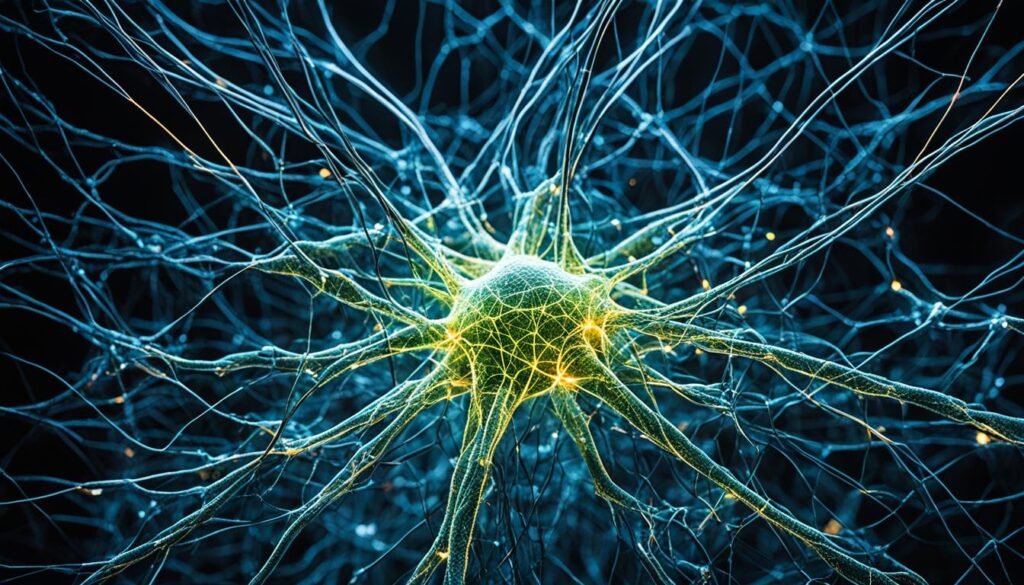
In the context of AI, the concept of neural activations is applied to interpret and make sense of the signals and outputs of artificial neural networks. By analyzing the patterns and activations within the neural networks, AI systems can gain insights into the underlying processes and make informed decisions based on the extracted information.
Both in neuroscience and AI, the understanding of neural activations contributes to unraveling the complexities of cognition and information processing. By exploring the activation-synthesis theory and its application in AI, researchers can uncover new perspectives and enhance our understanding of the brain and artificial intelligence.
Diverse Neural Activation Functions
Neural activation functions are mathematical operations within neurons that introduce non-linearity to neural networks. These activation functions play a crucial role in capturing and modeling complex patterns and relationships in data.
Sigmoid and Hyperbolic Tangent Functions
The sigmoid function and hyperbolic tangent function are common activation functions used in neural networks.
The sigmoid function produces values between 0 and 1, while the hyperbolic tangent function outputs values between -1 and 1.
These activation functions are particularly useful for problems involving binary classification, where the output needs to be interpreted as a probability.
Rectified Linear Unit (ReLU) Function and Variants
The rectified linear unit (ReLU) function is a popular activation function in neural networks.
It outputs the input directly if it is positive, but zero otherwise.
ReLU helps prevent vanishing gradients in neural networks and has proven effective in capturing and learning complex patterns.
Variants of ReLU, such as Leaky ReLU, address limitations and issues associated with the original function.
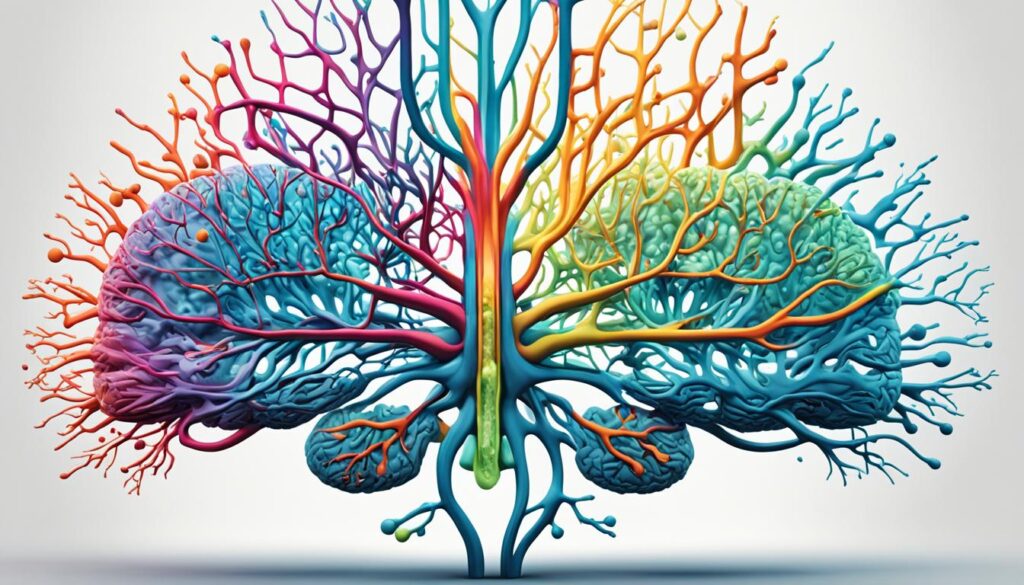
By utilizing diverse neural activation functions like the sigmoid function, hyperbolic tangent function, and the ReLU function, neural networks can efficiently capture and model complex patterns and relationships in data. These activation functions enable non-linear transformations within neurons, allowing neural networks to learn and adapt to varying decision boundaries and achieve better performance in various applications.
Challenges within Neuron Activation Research
As researchers delve into the intricacies of neuron activation, they encounter various challenges that require careful consideration and innovative solutions. Two significant challenges in neuron activation research are the issue of overfitting in artificial neural network (ANN) models and managing the complexity that arises from expanding neural networks.
The Issue of Overfitting in ANN Models
Overfitting is a common challenge that researchers face when training ANN models. It occurs when a model becomes too specialized in learning from the training data, resulting in poor generalization to new, unseen data. In other words, the model becomes overly adapted to the specific examples it has been trained on.
This issue of overfitting is particularly relevant in the context of neuron activation research since it can hinder the performance and reliability of ANN models. To address overfitting, researchers employ various techniques such as regularization and dropout.
Regularization involves adding a penalty term to the loss function during model training. This penalty discourages the model from assigning excessive importance to certain features or parameters, thereby promoting more generalizable learning. Dropout, on the other hand, randomly disables a fraction of the model’s neurons during each training iteration, encouraging the network to learn robust and independent features.
By implementing these techniques, researchers can mitigate the risk of overfitting and improve the generalization capacity of ANN models.
Managing Complexity in Expanding Neural Networks
As neural networks continue to grow in size and complexity, researchers face the challenge of managing the increasing intricacies that arise. Expanding neural networks with numerous layers and intricate activation functions require careful optimization and architectural considerations.
One aspect of managing complexity involves striking the right balance between network expressiveness and avoiding issues such as dead neurons or exploding gradients. Researchers need to ensure that the neural network captures the necessary complexity to effectively model the underlying data, while still being manageable and efficient.
Additionally, architecture optimization plays a crucial role in managing complexity. Researchers explore various architectures, activation functions, and connectivity patterns to find the optimal configuration that maximizes the network’s performance.
Moreover, techniques such as dimensionality reduction or feature selection can be employed to simplify the input space, reducing the complexity of the problem at hand.
By addressing the challenges of complexity in neuron activation research, researchers can continue to advance the field and harness the full potential of neural networks.
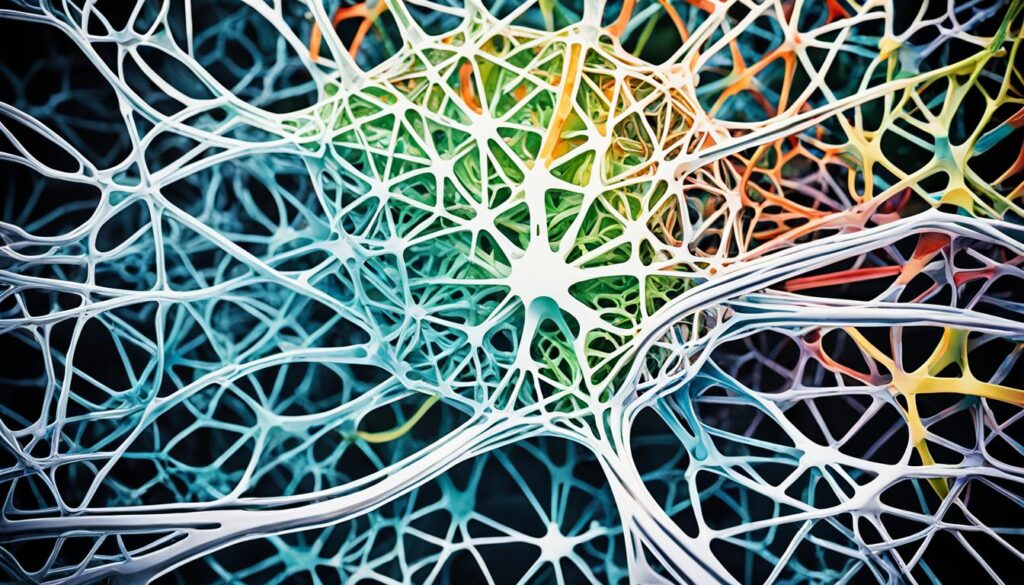
Conclusion
Neuron activation is a fundamental process that unlocks the brain’s potential and enables cognitive processes. By understanding the complexities of neuron activation and its role in the brain, we gain insights into the intricacies of cognitive function. The interplay of neural networks, excitatory and inhibitory signals, and diverse activation functions contributes to the brain’s capabilities to learn, think, and create.
Delving into the research on neuron activation holds the key to unlocking new possibilities for enhancing brain potential and developing advanced AI systems. From understanding the balance between excitatory and inhibitory signals to exploring the variety of activation functions, researchers are uncovering the fascinating mechanisms that drive our cognitive processes.
As our understanding of neuron activation deepens, we are better equipped to harness the brain’s potential. With the knowledge gained, we can develop strategies and techniques to optimize brain function, enhance cognitive abilities, and even create more sophisticated AI systems. The study of neuron activation opens up a world of possibilities for improving human potential and artificial intelligence.

